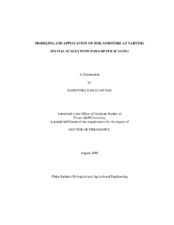| dc.description.abstract | The dissertation focuses on characterization of subpixel variability within a
satellite-based remotely sensed coarse-scale soil moisture footprint. The underlying
heterogeneity of coarse-scale soil moisture footprint is masked by the area-integrated
properties within the sensor footprint. Therefore, the soil moisture values derived from
these measurements are an area average. The variability in soil moisture within the
footprint is introduced by inherent spatial variability present in rainfall, and geophysical
parameters (vegetation, topography, and soil). The geophysical parameters/variables
typically interact in a complex fashion to make soil moisture evolution and dependent
processes highly variable, and also, introduce nonlinearity across spatio-temporal scales.
To study the variability and scaling characteristics of soil moisture, a quasi-distributed
Soil-Vegetation-Atmosphere-Transfer (SVAT) modeling framework is developed to
simulate the hydrological dynamics, i.e., the fluxes and the state variables within the
satellite-based soil moisture footprint. The modeling framework is successfully tested
and implemented in different hydroclimatic regions during the research. New multiscale data assimilation and Markov Chain Monte Carlo (MCMC) techniques in conjunction
with the SVAT modeling framework are developed to quantify subpixel variability and
assess multiscale soil moisture fields within the coarse-scale satellite footprint.
Reasonable results demonstrate the potential to use these techniques to validate
multiscale soil moisture data from future satellite mission e.g., Soil Moisture Active
Passive (SMAP) mission of NASA. The results also highlight the physical controls of
geophysical parameters on the soil moisture fields for various hydroclimatic regions.
New algorithm that uses SVAT modeling framework is also proposed and its
application demonstrated, to derive the stochastic soil hydraulic properties (i.e., saturated
hydraulic conductivity) and surface features (i.e., surface roughness and volume
scattering) related to radar remote sensing of soil moisture. | en |


